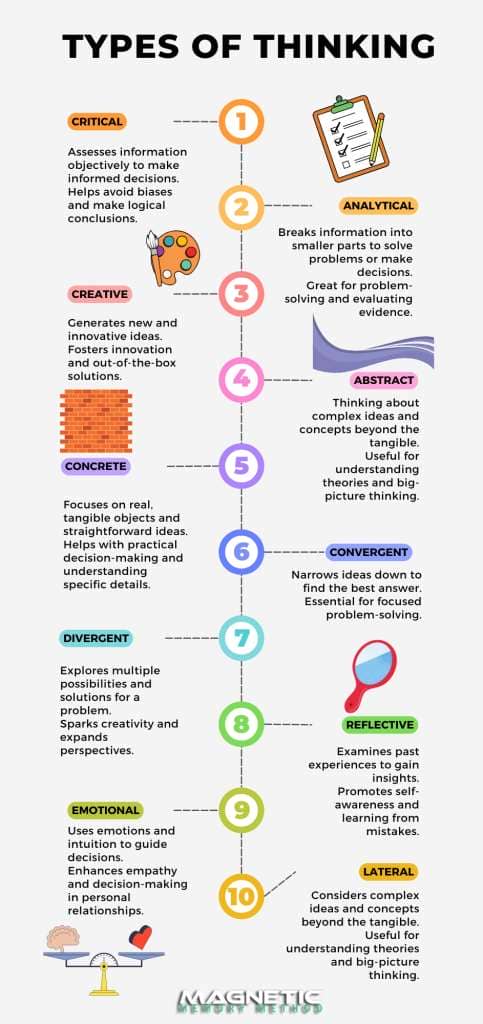Podcast: Download
Subscribe: Apple Podcasts | RSS
 Some people say there are as many types of thinking as there are people to think them.
Some people say there are as many types of thinking as there are people to think them.
Actually, no. In fact, such statements demonstrate very poor thinking.
Yet, I heard this claim all the time during the years I taught a fourth year university course in Critical Thinking.
But let’s give these people the benefit of the doubt for a second. It is true that many forms of thinking interact with each other, for example. This “intermingling” of ideas can make the list seem infinite.
However, everything to do with our modes of thought can be broken down into a smaller set of “thinking genres.”
And here’s the game-changer you need to know:
There’s a difference between types of thinking and methods of thinking. It helps to be clear about which ones you want to identify and improve. Find this clarity is what this post is all about, so let’s dig in.
To start off on the right foot, I’ve created a handy infographic for you.
It breaks down the main types we’ll be discussing today and summarizes the key points for each.
The 10 Types of Thinking
As you go through this list of thinking types, you might start wishing you were a master of each and every type.
This is possible.
To help you make it happen, I’ll provide tips for developing your skills with each and everyone as we go. Just remember that it’s a marathon, not a race. You don’t have to work on all of them at the same time.
As you read, keep two central questions in mind:
- What is thinking and why does this type count?
- In what ways am I already thinking like this in my daily life?
One: Critical Thinking
Critical thinking is about assessing information objectively so you can make informed decisions.
It helps you avoid biases and make logical conclusions. One ways it does this is by enabling you to evaluate ideas. You literally give them a value that helps you weigh their validity and compare and contrast their merits.
Critical thinking also helps you divide the content of various ideas from the form they take.
Let’s say someone is angry and yells at you about how they want you to change. Critical thinking would allow you to find the value in the suggestion and not miss out on it just because the form of address was unfriendly.

In other words, critical thinking allows you to place information in context and reason objectively about it. Being objective lets you keep your calm and continue searching for truth even when things get heated. Here are 11 more benefits of critical thinking to help you improve this type of thinking and continue seeking the best possible answers.
Why is critical thinking so important?
As mentioned, I taught critical thinking for several years at the university level. These experiences gave me a lot of practice in looking at both the shape that a large variety of arguments take.
To give you a more recent example, my YouTube channel has over 100,000 subscribers. As a result of having such a large audience, I regularly field disagreements in the comments. Often, when I respond to claims people make with critical analysis, they come back with a personal attack.
As a critical thinker, I spot this instantly as ad hominem in structure. Such people are trying to attack me instead of my ideas. Thanks to my knowledge of critical thinking and rhetoric, I can keep calm and carry on with reasonable and rational responses.
Once you start exploring critical thinking, you’ll start to see issues like this in your own conversations and in the media. You’ll navigate many debates much better and save yourself a ton of stress.
Two: Analytical Thinking
Whereas critical thinking helps you evaluate value through analysis, analytical thinking is about examining the parts of an argument. It looks much more closely at the thought process.
To examine information as analytically as possible, this thinking type breaks information into smaller parts. It helps with evaluating the bigger picture when you can zoom in and assess components.
That’s why analytical thinking typically involves research. As an analytical thinker, you will not be satisfied by the data at hand. For each part your analysis reveals, you will seek multiple examples and connections so you can compare and contrast the multiple parts with as many other examples and case studies as possible.
To improve in this area, developing your reflective thinking skills will be of tremendous value. We’ll talk more about how do this in the section for the eighth type.
For now, the key to analytical thinking involves enabling yourself to take multiple positions.
This is an important part of analytical thinking because we all have memory biases.
One way I help to reduce my own analytical errors is to host plenty of conversations on my podcast with other memory scientists and memory athletes.
By collaborating with other experts through conversation, multiple levels of analysis take place because they can help break things down and connect ideas to the bigger picture.
Collaborative analytical thinking also encourages thousands of people in the audience to share their thoughts. As a result, we all benefit by having more details, examples and connections to consider.
Three: Creative Thinking
Edward de Bono is widely considered one of the leaders in the field of creative thinking. For him, it was a process of discovering solutions that are not obvious under normal circumstances.
To help people, de Bono developed a number of processes, most famously lateral thinking.

You can visualize this form of metacognition by thinking about digging holes. As de Bono points out, most people dig one hole and if they don’t find the answer they’re looking for, they dig another hole in a different location.
Lateral thinking, on the other hand, digs tunnels in sideways and diagonal patterns. Moreover, it does not throw the dirt away as if it were obscuring the solution. It finds new ways to use the dirt.
If you want to improve your creative thinking, de Bono’s practices are useful to look into. However, it’s important to note that “creative” isn’t quite the right word because no one is “creating” anything new.
It’s more about using existing processes in unique ways to generate new ideas that you would not reveal any other way. And, as Leslie Owen Wilson points out, creative thinking usually involves risk taking as you add layers of complexity to those existing processes.
When writing my Memory Detective novels, I use creative thinking often. One of my favorite tools for jogging new ideas is a simple question: “What would happen next if this story was real?”
Like De Bono’s lateral thinking, the creativity this question creates stems not so much from fantasy, but from digging sideways into possibilities that I wouldn’t think through otherwise. I create new avenues of thinking through the inquiry process.
Four: Abstract Thinking
Abstract thinking begins with symbols.
For example, there’s no reason why the shape of the letter ‘A’ should be pronounced as we use it in English. In fact, it’s pronounced quite differently in, say, German.
The ability to understand that fact is a simple example of abstract thinking. Later, the use of ‘A’ as a symbol in logical and math provides a more complex example.
Jean Piaget is a major influence on the description of this technique. As he pointed out in his theory of cognitive development, children start developing basic symbolic thinking abilities between the ages of 2 and 7.
Between 7 and 11 they move on to develop logical reasoning abilities. Basically, everything after that is devoted to abstract thinking, and we do not stop until death.
To improve your abstract thinking abilities, study subject areas like:
- Math
- Philosophy
- Game theory
- Logical thinking
- Play with figurative language
- Practice visualization meditation
- Use a Memory Palace
- Learn other languages
Five: Concrete Thinking
Concrete thinking is about taking the world literally – or seeking ways to do so. It’s also called literal thinking.
This kind of thinking leads you to ask for specific examples. If someone makes a claim, you want to know what makes it true, why the evidence actually supports the argument and how exactly it does so.

Sometimes people avoid concrete thinking because they don’t want to appear stubborn. However, we need more people to insist on evidence that supports the claims people throw around, well… and insist concretely.
To improve in this area, ask lots of questions of the who, what, when, where and why variety. And follow-up by applying some of the characteristics of analytical thinking, such as performing due diligence with your own research.
If you find it difficult to remember asking questions like that, consider using a memory wheel to help.
I already mentioned critical thinking above, especially when dealing with ad hominem argument structures. Pointing out the devices people are using and asking them to return their focus to the substance at hand is another example of concrete thinking. You can learn a lot about how to engage others concretely during debates by reading a book called Rhetorica ad Herennium.
Finally, I encourage you to take some time to learn how debate prep works – even if you never plan to debate formally. I make this suggestion because debating involves a lot of concrete thinking processes, such as offering concrete evidence in support of your claims.
Plus, you’ll learn how to point out in a reasonable way when others have neglected to provide and describe concrete evidence of their own.
Six: Convergent Thinking
Convergent thinkers look for examples that expose commonalities and reject the distortion of having all kinds of wild ideas flying around. They do this to find the best possible solutions to problems.
NASA provides many examples of convergent thinking – something that is also basically the same as linear thinking. For example, the Apollo 13 mission faced a critical situation where they needed to get enough energy to safely complete the mission – and save their own lives.
To solve the problem, they had to focus on using only the materials they had on hand. By doing so, they were able to quickly and reasonably converge on the best possible answer.
If you want to improve this form of thinking, solving puzzles where you are limited to only the pieces you have and cannot bring any outside parts provides great practice. Escape Rooms are great for this, as are games like Hunt a Killer where you solve crimes based solely on the evidence provided.
Seven: Divergent Thinking
Let’s stick with that NASA example.
When Apollo 13 was in danger, apparently someone suggested they use a flashlight to create more energy.
Of course, the space shuttle team didn’t have a flashlight, so they had to use convergent thinking instead to reach a solution.
However, that doesn’t mean throwing out a wild idea like “flashlight” is entirely wrong. Sometimes you need to brainstorm using this form of nonlinear thinking to trigger ideas you couldn’t arrive at otherwise.
In some ways, divergent thinking is a lot like lateral thinking. In this case, it’s often best conducted in groups.
To improve, you might consider holding what is called an “Idea Party.” I’ve attended these for entrepreneurs and people who need help kick starting an initiative they’re passionate about.

Basically, each person gets a few minutes to describe their project. Then the audience spends 10-15 minutes sharing their best ideas and resources for making the idea happen. It’s a powerful exercise because it gets many different thinking types to respond in many divergent ways in a short period of time.
Eight: Reflective Thinking
Reflective thinking involves examining past experiences and knowledge to gain new insights.
When practiced frequently, it promotes self-awareness. It also helps you learn from mistakes.
I combine reflection with analytical thinking all the time, especially on this blog.
For example, it is an important part of memory science to analyze data, and then reflect on our conclusions about what it means.
We also need to analyze what scientific data doesn’t mean because that will help us from making critical thinking errors.
Reflective thinking is fairly easy to do. You just need to set the time aside for it. Unplug from devices, get out a notebook and jot down what you think, feel and arrive at logically about whatever issues you’re considering.
Nine: Emotional Thinking
A lot of people think that being guided by your emotions is a bad thing.
I disagree, at least to a certain extent.
You can use emotions and intuitions as a springboard for other kinds of thinking. Reflective thinking, for example, draws upon past experiences, which include emotions you’ve experienced.
Drawing regularly upon your emotions can help enhance your empathy, decision-making and how your navigate your relationships.
As these researchers point out, just because we have an emotional component to our thoughts, doesn’t mean that they lack organization.
Scientists aren’t alone in noticing that there’s a structure to our emotions and how they impact thought. One of my favorite philosophers, Robert C. Solomon published The Passions: Emotions and the Meaning of Life back in 1993.
One of this key arguments is that emotions have their own form of logic. I highly recommend studying the logic of emotions in greater detail so you’re better able to consider how they influence the flow or your mind.
Ten: Lateral Thinking
Lateral thinking is a term probably first coined by Edward de Bono.
In a nutshell, it involve tackling problems from different angles and sometimes indirectly.
For example, if a city needs to reduce traffic congestion, often planners will tackle the issue directly by adding more highways. Or they will add toll systems thinking they will manage traffic flow.
Lateral thinking, on the other hand, approaches the problem by thinking about how the city could encourage people to take public transport or ride bikes more often.
Or, it might consider work-from-home incentives so that people aren’t commuting daily nearly as often.
Later thinking often winds up solving more than one problem at the same time. In the traffic example, not only would the lateral thinking findings reduce travel.
Pollution would be decreased as well, potentially leading to fewer problems like brain fog.
How to Find Your Thinking Type: 4 Strategies
At this point, you might be curious to know what kind of thinker you happen to be? Are like one of the people who has the highest IQ? Or are there any signs of genius lurking in your mental life that you have yet to uncover?
To find out, here are some suggested ways to explore how you think, or at least discover which thinking types you lean towards by default.
One: Explore Your Personality Type
Although the whole notion of personality types is not without its controversy, researchers use the concept, often to great effect.
In this study, for example, researchers found that students with a higher amount of openness were better able to explore new kinds of knowledge.
Openness is the first of what are called the Big Five Personality Types, or OCEAN:
- Openness
- Conscientiousness
- Extraversion
- Agreeableness
- Neuroticism
I’ve used the model to examine myself quite a few times over the years. Although I don’t use these exact terms, my popular TEDx Talk shows how I was able to use a mixture of memory and meditation to move from a high level of neuroticism to openness.
I would say that my thinking type is much more open as a result of these experiences. It seems to me that my practices have also helped me better understand the connection between memory and intelligence.
Overall, exploring your own personality type lets you use all of the thinking types we’ve discussed today. OCEAN, for example, is analytical because it breaks personal characteristics down into smaller components.
You can then apply principles from emotional thinking, creative thinking and even lateral thinking to discover more about how you and others tick.
Two: Examine Your Childhood Development
Cognitive development happens in stages. It’s usually around age 12 that we’re able to think critically.
But some of us think more creatively and prefer to brainstorm with or without rules.
By thinking through how you developed from early childhood into adulthood, you can gain insight into how you’ve developed into particular styles of thought. You can also discover clues that might help you experience change if that’s something you desire.
Three: Discover The Philosophy of Mind
Believe it or not, people disagree about what exactly it means to have a mind.
For example, some people think that the human mind is unique. In Kinds of Minds, however, Daniel Dennett challenges this notion. He suggests that many kinds of sentience exist. Other animals might have a language instinct and, if this is true, our experience of mind might be more similar to animals and even an artificial intelligence.
Asking philosophical questions like these will challenge both how you think as an individual, but also how you think as a member of your species.
But don’t worry. You’ll be in good company. People like St. Augustine went through similar exercises long ago to try and determine what kind of thinker he was.
Four: Discover Your Emotional Intelligence
Sometimes how you think has more to do with how you think about your feelings.
This is one of the core premises of emotional intelligence. As some researchers argue, your emotional intelligence can act as a “rudder” that guides you through life.
The different types of emotional intelligence, or emotion-driven thinking include:
- Empathy
- Social skills
- Ability to motivate yourself
- Self-awareness
Examining your own life for your strengths and weaknesses in these categories can help you understand your thinking style better.
How To Improve Your Thinking Skills
As I mentioned at the beginning of this article, there’s a difference between types of thinking and methods of thinking.
Some of the methods you’ll want to explore include using all of the above in the form of:
- Writing
- Studying
- Mind mapping
- Discussing
- Debating
- Meditating
All of these activities need to be scheduled. Without regular focus and consistent practice, your thinking abilities will speed up.
The good news is that you can use each thinking type we discussed above to make time for practice. And if you need more help, these critical thinking examples and critical thinking strategies are here for you.
So what do you say? Are you ready to explore new types of thinking? Get out there and enjoy the benefits working with higher quality thoughts will bring you.
And if you’d like more help with remembering these kinds of thinking, please sign up for my FREE Memory Improvement Course:
Using mnemonics will help you think about the entire world in a whole new light.
Let’s turn your dream of being a better thinker into a reality!
Related Posts
- 11 Benefits of Critical Thinking That Rapidly Improve Your Life
Critical thinking provides so many benefits. But did you know there's more than one kind…
- 9 Critical Thinking Strategies That Lifelong Learners Need To Know
Reading on its own is not enough. You also need critical thinking strategies. Here are…
- 7 Critical Thinking Examples That Will “Bulletproof” Your Mind
Real life critical thinking examples are hard to come by. This post gives you 7…









6 Responses
Systems Thinking?
Field-based Thinking?
Thanks so much.
I would expect that analytical thinking’s use of research would reveal the systems, fields and other categories involved in any number of disciplines. Or do you have something else in mind? Field-based learning is a term I’m familiar with, but it tends to involve getting out into a field where a discipline and its systems of thinking are practiced, typically in an analytic manner.
I’m pleased to get these 7 types of thinking because it helps to understand yourself the type of thinker you are and others. It can help to apply to different situations.
Thanks, Addis.
Yes, knowing different thinking types and styles definitely makes is more robust in a variety of situations.
Thanks so kindly,
Knowing the 7 different types of thinking really helps improve my life
Glad to hear it!